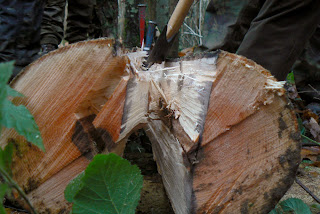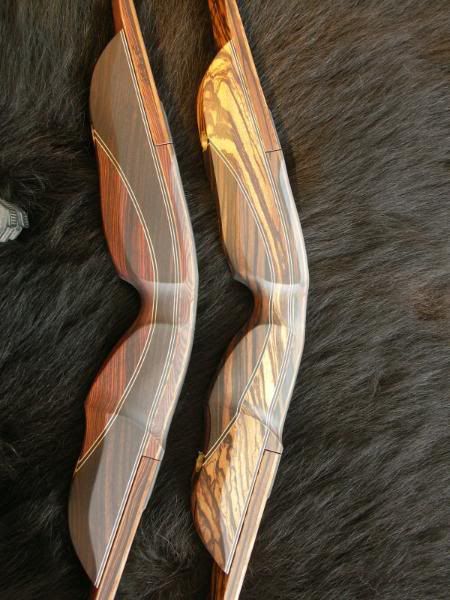Sorry for the few days of silence, I was away on a school visit in New York and didn't work on anything. The good news is that there is TONS of bow wood there and a couple archery places, so that's cool.
Good news! I got a special delivery last week:

That's right! It's wood! That, fine sirs (and ma'am's), is a split-from-a-tree stave or Oregon Ash, harvested the traditional way. With a chainsaw. You may be saying "I can't keep up with what bow is being worked on when plz stop!" and I understand. The thing is, the recurve is more or less my wife's project, which means progressing on that will be spotty. The oak longbow (the one I heat treated and will back with canvas) is mine, and I'll be working on that, but It's already a bow and after backing, there isn't really any bow making to post about. This stave gives me an opportunity to make a more traditional bow, and post all about it. I've talked a bit about split staves, but I'll go into some more detail now. Again, sorry, no actual bow making right now, just info.
Basically, you find a tree that's straight, cut it down, and split it into staves. It's a bit more complicated than that, though. First off, tree selection is key. You want one that isn't twisted like this:

You don't want one full of knots and kinks like this:
http://www.lastgreatroadtrip.com/wp-content/uploads/2011/02/knotty-tree-202x300.jpg
Perfection is not as important, though. You don't want pin knots and branches, and you want the tree to be fairly straight, it's not like the lumberyard. Going to the lumberyard is a difficult process of careful selection. The grain MUST be perfectly straight, because the board was cut perfectly straight. When it comes to trees, You don't have to cut them straight, so you can be less picky. Look at this bunch of trees:

ALL of them can be made into bows. Each tree has at least 6' of straight, branch free trunk, and They are all a decent diameter. See how much easier it is?
Step One would be to cut down the tree (Duh). Cut it close to the ground, and IMMEDIATELY coat the cut surface with something to seal it. Many people bring a can of shellac and paint it on the cut. When you cut the tree, moisture will rapidly escape through the cut surface, drying the last few inches faster than the wood inward a bit. This will cause drying checks (cracks) which you don't want. The shellac stops the moisture from escaping out the ends. Some say certain woods like osage will audibly crack within seconds of cutting. This is bad. You also want to cut the section of wood a little too long as a protective measure against these cracks. If you get some minor checking, you can cut the ends off.
You don't want the top part of the tree, just a 6-7' section of the trunk. IF the tree has a long straight truck, you can get more than one section per tree. If you end up with a 4' section at the end, take that, too. You can splice them together or make take down bows.
When you get everything home, split it into quarters. Somewhere on this thread is the mention of a youtube channel that I can't seem to find. On there somewhere is a video of them splitting osage. Watch that if you're interested. I've never done that, so I don't have personal pics, but I did find this:

Split in half, split those in half. If the tree is big enough, each quarter will have 2 or 3 bows worth of width on the outer surface. You can also bandsaw out another one from under that, but I don't have pics. The bowyers bible 1 has some great info and pictures about that, but I don't feel comfortable posting a copy of their stuff online. If you want those books and buy from "bois d' arc press" you're actually buying from one of the main authors directly. Bois D'arc is a name for the osage orange tree, btw.
Now take your staves and let them dry for a long time. I hear a year per inch of thickness. I've also read you can rough out the shape of the bow and let it sit for a couple months. Thinner means it dries faster.
The staves I bought were cut 10 years ago, according to the guy (look up vinemaplebows and you'll get his website. He's a good guy who just does this on the side because he loves bow making) so they should be plenty dry.
Tip: I hear cutting wood in the spring/summer is better than winter, since the bark will come off easier. Again, I've never cut the wood down, so I can't confirm that.
My stave is about 2" wide, 70" long, and an inch or so thick, except at the middle where extra wood was left for a handle. Yes, the guy did the beginning stages of bow roughing already, and these staves were dried and affordable. I'm totally buying from him again.
In most species of tree, you remove the bark and the surface left is the bow's back. Since the bow was split, following the grain lines of the wood, you will have uninterrupted wood fibers (what you want) from tip to tip with no run off. It will usually not be perfectly flat:

This is fine, because you don't want perfectly flat, you want unviolated wood fibers. With a board, the back is cut perfectly flat, so you need perfect grain to have unviolated fibers. This little bend will result in a hump in the limb. I'll have to carve the belly to follow the shape of the back. Some people, who love a challange, take this to the extreme.

Fibers are not violated, so the bow stays together. If that were cut into a straight board, it would break. If I sound like a broken record here, it's because fiber violation is THAT BAD of a thing. This preservation of fibers in a bow can even lead to knotty bows that don't break:

Notice something here, the knots are weak spots, but the tree compensated by making the wood thicker and wider around the knots. The bowyer simply followed what the tree did. The back is one growth ring of the tree and the sides are straight fibers. If you don't like the look, then don't buy knotty wood. Leave that for people who like that kind of thing. Personally, lots of character doesn't 'do it' for me, but I do find them to be impressive displays of bowyer skill. The main challenge is trying to figure out if the bow is bending evenly when it wasn't straight to begin with!
Some woods are different, though. Osage, for one, is known to have crappy sapwood (the stuff just under the bark). Yew is the opposite, it's sapwood is awesome, but it can be too thick. You don't want a yew sapwood belly, and you don'w want an osage sapwood back (although some have gotten away with it). In that case, you have to cut down the back. It is important here that you 'chase a ring'. Basically this means you have to cut off a few growth rings and leave another one intact. This is a lot of work, and it generally takes lots of painstaking work with a scraper.
I may get to do this with my ash bow. The surface just under the bark on oregon ash makes a great bow back, but the rings are crazy thin. If I make just one error, I could cut through a ring. Then, i'd have to chase the whole ring from tip to tip. I don't want to do that. Some people cut the wood in the late spring, and peel the bark right off before drying, leaving a clean surface from the get go. The guy who cut this wood didn't do that, and on some woods that isn't advisable. Surely the bark offered some back-surface protection during shipping, too.
This bow will not have any glued on handle, and I may not even glue on tip overlays. Oregon ash isn't super hard, though, so I still might do that. I'll figure that out later. I may also scour some books and imitate tips found on some old bow. That bois d arc press has a good variety of other bow books, too, and i'll likely copy something from one of those. More decisions have to be made, and i'll keep you guys updated.
East2west: Did you get it tillered to full draw yet? any pics? Can Earl work the camera while you shoot your first shots? I'm fairly sure after you take a few shots you'll immediately start working on the second one. These bows are like crack. You can't have enough. Ever. Unfortunately, arrows are even worse, since you need lots of them for every bow.
Anyone else making a bow yet?














 http://3.bp.blogspot.com/_kerdDztYpts/SYzpG1jhoKI/AAAAAAAAAEc/tVLXbcm9kCU/s1600/18+nock.JPG
http://3.bp.blogspot.com/_kerdDztYpts/SYzpG1jhoKI/AAAAAAAAAEc/tVLXbcm9kCU/s1600/18+nock.JPG




















